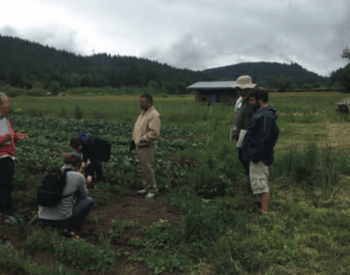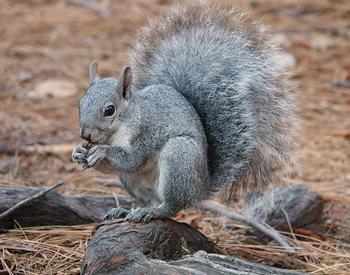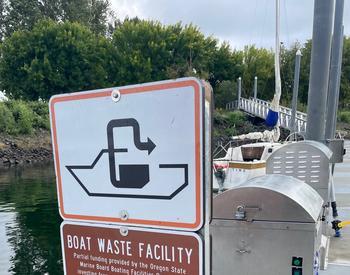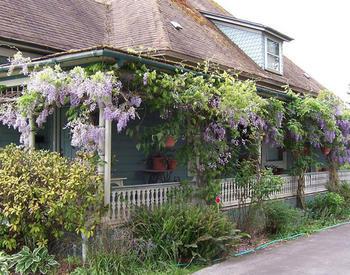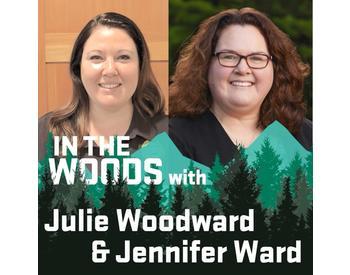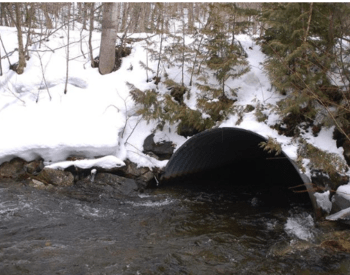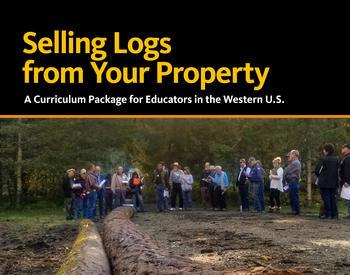Transcript
From the Oregon State University's extension service, you are listening to In the Woods with the Forestry and Natural Resources Program. This podcast aims to show the voices of researchers, land managers, and members of the public interested in telling the story of how woodlands provide more than just trees. They provide interconnectedness that is essential to your daily life. Stick around to discover a new topic related to forests on each episode. Welcome back to another episode of In the Woods. I'm your host Lauren Grand, assistant professor of practice and extension agent in forestry and natural resources at Oregon State University's college of forestry. Today's episode we're talking about small landowner management. And with me I have a small woodland owner, Lindsay Reaves. Lindsay, say hi, tell us about yourself. Hello everybody, my name is Lindsay Reaves. I live and work on a 670 acre tree farm with my husband Tom Bauman. It's been in his family since 1945. I don't have a forestry background, but with the help of extension and other programs have learned a lot about forest management. Great! So, give us a little bit of a description of some of the objectives you have on your forest. So, this is a working tree farm as I mentioned it's been in my husband's family since 1945, three generations, and we have as our primary objective on this tree farm cutting down trees to take them to the mill because this is how we make our living. With that said, we have also over the last few years put a lot of our tree farm, approximately one-third, into a conservation easement for habitat. And we also have a small fish stream on the tree farm so we manage for the riparian needs, desires, requirements that the state asks us to do requires us to do. And so within the timber operations there's other if you will tendrils or aspects of things that we need to manage for. Both Tom and I are very passionate about the wildlife here on the tree farm and in many ways we see this working tree farm really as their home and so we're sometimes going above and beyond the the rules and the objectives for timber management to include habitat and um just recognizing that this forest because it has so many different stages of of tree growth for example I'm standing in an area where the trees are about uh 15 years old and then right next to these trees are other trees that are 80 plus years old and so we have a lot of different edges if you will for habitat but it's still um the main objective is using this working tree farm so that we can provide income for ourselves and timber for the mills. So, I had the pleasure of being on this tree farm today with Lindsay with a bunch of students. And so one of your other objectives is forestry education. So, tell me a little bit about some of the education things that you do on the property. Yeah, thanks for that Lauren because I always since we bring kids on just twice a year I sometimes forget that that's a really important part of what we provide as well. So, through um mostly an organization called Forest Today and Forever, which recruits our volunteers and works to reach out to the teachers in the school system. We bring on about a thousand kids in the spring and a thousand kids in the fall. And it's a curriculum program catered to math science standards where children come out to the tree farm and gather data and then go back into their schools and develop their own management plan for their fictitious family. I'm also on the board of the long time watershed, so we do some classes out here with our watershed audiences. Um Lauren and I just got done with a meeting we're going to be doing some other programs out here for extension looking at riparian areas and water and culvert replacements. And I also work with the University of Oregon, we do tours out here for students with the pacific northwest history class taught by professor Beda. Yeah, so there's lots of opportunities to take people who don't always get the opportunity to see a working forest out to out to the woods to learn more. So, you talked a lot about wildlife being a really important management activity for you in incorporating wildlife habitat into all your management activities. Can you talk a little bit more about some of the specific things that you do for uh creating a diversity of wildlife on the on the property? Yeah, and part of this is uh Tom and I's choice making if you will for going above and beyond the forest practice rules. And I think a lot of it for me also looks at since we live and work here 24/7 we're really able to kind of get to know our neighbors if you will and also get to see how habitat changes happen via either disturbance like the big snowstorm, ice storms that we've had. Or just as the forest matures and grows different things that will bring in different types of animals different types of critters. So, for example, we're standing again in a in a smaller forest with a bigger forest right on our edge. And as that smaller forest grows up and those trees become more mature, that will create a new type of habitat for other critters and it'll habitat that for example the bird life might have enjoyed in that forest will will go away. And so what we're always looking at on the tree farm is how do we keep this what I call both the vertical and the horizontal diversity so that the different types of critters that need early sterile or younger forests will have those types of forests. Animals that prefer a more mature forest say a 30-40 year old forest will have that forest available, and then we do have parts on the tree farm where we've got some older stands uh second second growth timber that are around 80 years old or so with a few trees on the tree farm that are in that 300 year old range, so some really nice big ones. And part of our management plan is also looking at what are called special sites so those really big trees we will not be cutting those down because those serve a habitat that took obviously a long time for those to get there. The other thing we're starting to look at is on the tree farm places that have the oaks so that we can bring in some diversity with other tree species and we're actively going into those a few stands of oaks that we have and selectively taking out the Douglas fir so that those oaks have the kind of sunlight that they require. And those oak habitats are becoming important for other types of species of animals who really need those hardwoods and the kind of for example the acorns that that fall to the ground from those trees. We also have a fish stream and so what we look at is what are the kind of habitats along riparian areas that critters need so the salamanders the slugs yeah the kind of moist excuse me the moisture kind of oriented critters we have salamanders we have all sorts of animals that really need those riparian areas. And Lindsay likes to emphasize salamanders around me because she knows how much I love amphibians and reptiles. And I also have to tell the story I always tell the story about how Lindsay gave me my appreciation for slugs and snails um because she always moves them off the trails when she's walking to make sure that nobody gets squished. Yes, with that said too we have invasive slugs and snails and some invasive plants and so part of the overall habitat is to remove um those invasives so that the native plants and animals can have the habitat that they really need and desire. So, one thing that's not my favorite activity but every year I get my my boots and my personal protection gear on and I'm out searching for the different invasives that naturally seem to be occurring in our forest these days and doing my best either through mulching, hand pulling, or using the appropriate herbicide and the appropriate amounts of herbicide to remove those invasives off of the landscape.
One one other piece that we've really looked at with habitat and habitat diversity is when we do a final harvest clear cut. We are required by the law to leave a certain number of snags and a certain number of chunks of downed wood of certain size. And what that does is it brings in the the bugs and the beetles and those bring in the birds and the birds make the cavities and the cavities bring in other critters and so you they call I've heard them called wildlife condominiums with the standing snags. So that we see owls and other critters that really use those and as those snags will eventually fall to the ground that just continues the the habitat diversity on the ground for the the other critters that really need that kind of moist decaying dying dying wood that's on the ground. So, what Tom and I will do is we'll oftentimes go above and beyond and leave more snags that then is required and leave more downed wood on the ground as well.
So, you're doing all this great management on the tree farm to attract wildlife, have you had any fun wildlife sightings recently? Actually, yes, and I think that's the other part I like about the the wildlife is you never know who's going to show up. And so this year we had for myself the first sighting of about 60 herd of elk. And we knew that there was elk around us on other adjacent tree farms and forest land but had never seen them on this on this forest land and so kind of spooked them and they were very loud and they just kept running by. And I used to be scared about cougars thinking that you know if I was going to have an encounter that might be the the one that I would need to be most um aware of that I could get harmed. I do walk the tree farm a lot by myself and I'm never in a position where I think something's gonna attack me, but you know big kitty, big big claws, so that was always kind of my "Okay, if you happen to see one, what do you do?" Just be mindful of that I do live amongst other animals. I feel like it's reasonable to be prepared for... It's good to know... something like that. Um but when I saw the herd of elk I was thinking nope elk is now my big "What do I do if I'm in the middle of a stampeding herd of elk?" A few years back I found my first box turtle which was kind of fun. Tom my husband had never even seen a box turtle here. It's rare but we do sometimes see the the giant salamanders which is very fun to see so you kind of never know who's going to show up. There's there's the usual suspects we see deer every year, I call them rats with hooves because they like to eat our little trees and get into my garden setting. We hear a lot of animals so here um owls hooting it's really fun this time of year in spring they'll hoot back and forth trying to find a mate and um the pileated woodpeckers are really out and about right now nesting so they're they're a fun call to hear. And what I mostly see when I'm on the tree farm just know who's who's out here with me is scat or the the nutritional material left on the ground as they're moving through, so. When I tell the kids you know are we gonna see a bear are we gonna do this it's like you'll probably see scat and that really gets them excited. Okay, so what um I have to imagine that um in all of the management activities you do since your family's living is you know to the tree farm, are you concerned about wildfire at all? Is there any management you do on the tree farm to help minimize your risk? So, concern about wildflower fire, yes, very concerned about wildfire because we not only live in the middle of a forest with our home and this is how we make our living so literally the the opportunity for for income could be lost in a day if not in a few hours, but we have forest land all around us and so what we do with our forest fire objectives is try to keep the fuels as low as possible so all of the roads skip mowed. And also we have a really good relationship with the Oregon Department of Forestry Wildlands fire crew. We actually do trainings out here with them so that they know where our roads are. And then we also monitor Oregon Department of Forestry because they are responding to fires all around us and so by knowing where potential fire starts have occurred or a fire is burning before they can get to that fire and put it out. We know that oh there's a fire right over on Lorraine highway and the winds are moving this direction, so maybe we should get our water tender out ready and available because we do operations on the tree farm. We follow the the IFPL's the International Fire Precaution Level Rules of when we can be running machinery and when we can't. We have all of our fire tools our fire extinguishers a few years back we bought a 3,000 gallon water tender and so if if a fire were to occur on the tree farm we are literally ready to respond to that ourselves because we see ourselves as having the best opportunity and it's actually the law to respond to a fire with the appropriate tools ahead of time. So, you're well you're really prepared knowing what fires are in the area and what to do if one happens, have you done any preventative measures around your forest like pruning or thinning in certain areas in case a fire does come through? Yeah, so as I mentioned we do live on this tree farm so our house is as fire safe as we can when we built it we built it with a metal roof and appropriate kind of a hardy hardy back hardy plank siding. With certain trees actually had to be cut because they were too close to the house according to Lane county to get permission to build. We also have a lot of green fields around our house so that we can have that that that green buffer, green zone whatever it's called leaning... Defensible space... Defensible space, thank you. Um and with the with the forest, we are especially next to the the road systems or places that a fire could potentially get started through um you know literally by accident if a car hit a rock or the um the brush hog that I mow with hit a rock. Is we do what's called the the lifting or the um getting rid of the ladder fuels of the the trees so the latter fuel is the lower branches that you can trim up so if the fire does come through they're meeting the the bark of the tree without all the other limbs that could be hanging down that are more of the fine materials. And if a tree is in the forest and is dying or dead, we are getting those trees out as quickly as possible because not only does that become a fire hazard but also it's the bug beetle infestation that can cause that tree to to die and that tree then becomes a tinderbox if you will if a fire were to come through. So, um have you been seeing a lot of or a large increase of beetle populations on your forest recently through the drought that we've been having? Yes yes yes and yes. And so going back to managing objectives you know a healthy forest is one thing that we're striving for in in general for habitat as well as for trees that are what the mills want. And I would say the last five, six years uh five years specifically with the droughts that we've been having is they're just more stressed trees, they're not getting the the moisture that they need, and we are able to assess literally from a distance we could see a tree out there that the top is no longer green. So, we will go out and get that tree out as quickly as possible. Um I can't really give a percentage of how many trees are dead and dying, but all we've been doing lately is salvage logging, a little bit of thinning to try to increase the the water content in the soils for the healthy trees, but we've literally made our living over the last three years just salvaging dead and dying trees. That must be really difficult to have to continuously watch trees sort of start to die on the property and sort of adjust your management objectives to try to meet meet the conditions that are occurring. Yeah, and I think the other part that is challenging that maybe folks don't recognize sometimes with logging practices is there's a tree here there's a tree there sometimes there's a road to get to that area sometimes there's not so it's very time consuming. And it also takes a lot more fuels and resources and wear and tear on the machinery to go chase that that tree here and that tree there. We also don't know when we see that tree at a distance how how much wood is in that tree or how salvageable that tree is and so sometimes you're going out and bringing a tree out of the forest and it's what the mills want, it's the right size, sometimes it's not sometimes, it's oversized so then that's a different sort sometimes it's really only good for firewood. So, it's kind of a hit or miss of what what we're going to be taking out of the woods. Luckily, right now, we have a couple of folks who are able to help us with processing that firewood because again these these trees are dead and dying because of oftentimes drought stress and potential beetle infestation, so we want to get those trees off the tree farm as soon as possible and really get that wood to a place or a person that can utilize it, so if if it's something that the mills can use great, if it's something that a person can use in the winter for their firewood we've got like I said a couple of people that are out here helping us with that and it's just a gratis we it's a win-win for both of us, they get the wood and we get the wood off the landscape. Right, and so in this situation you don't choose to leave the dead trees for wildlife habitat because you were potentially trying to remove beetles from the property in order so that you don't see a population boom. Correct because once that, and you know more about this than I do Lauren, but once that beetle infestation flushes. They're out looking for the next dead dying stressed out tree and so if those trees aren't removed from the landscape with active beetle population, your forest does not stay healthy with a stand of trees that can really resist those beetles. Alright, great.
So, we're we moved to a new location on your property and we're standing next to a stream, so, tell us a little bit about the stream we're standing near. Yeah, so this is called Neuschwander Creek. Neuschwander, a little history I did is named after Merle and Norm Neuschwander who were homesteaders on this not so much on this tree from property but right kind of next door to us. It is classified as a small fish stream, so with the looking at forest streams on forest land and the kind of management activities that we need to maintain from Oregon Department of Forestry forest practice rules. We either have fish streams, non-fish streams or domestic water streams so this is a fish stream and it is a small fish stream based on the amount of water flow that comes through it. It is spring fed and so the water levels will shift fairly dramatically in the summer when we're not having a lot of rains even though the stream is still running we will see the water levels drop pretty significantly, but when we have some pretty high rain events it can flood. And the concern with the flooding is we have a lot of road systems on this tree farm that over across the creek in different places and the way that we can do that is through culverts. A lot of these culverts were put in 25, 30, 35 years ago before we had some of our knowledge base and some of our forest practice rules. And culverts will naturally fail over time and so we had that opportunity happen for us a few years back where the rain event caused the bottom of the culvert that had rusted through the water diverted itself around and a huge sinkhole occurred in the road that we used to access half the tree farm and so we were able to, with the help of Oregon Department of Forestry, look at are we going to replace the culvert with another culvert which for fish streams has a lot of complications and qualifications of the kinds of culverts that you can use. And instead we decided to put in a bridge uh which was about twenty thousand dollars, so that's part of the fun I guess with the tree farm is you never know where you're where your expenses are going to happen um but we were able to do that in about four hours because we have our own equipment so that that was a real blessing in that regard, so now that part of the stream is fish accessible uh the bridge is going to last a lot longer than a culvert would have and is a lot more resilient to any kind of flooding events. And so what we're looking at now with the fish stream is where are the culvert breeches where the fish really cannot access going further upstream and kind of start in a longer term management plan maybe the next five to ten years unless we have another culvert that completely collapses on us of replacing at least three culverts with bridges. Uh which will be good for us and good for the fish as well as the other critters. And then in that same regard because of these culverts that is put in a place where there's a road. And so with types of runoff especially in the winter that can happen we want to make sure that no silt goes into the fish stream and so we do what are called water bars so every fall we go out and put these kind of cross ditches in so as the water is running down these very compacted roads it doesn't create grooves and develop even kind of little creek creek beds in our road which then eventually could go into the creeks. So, those water bars are put in every fall and then every spring after our rain events have passed we go and we knock those down so we have access for whatever on the tree farm for running equipment up there for making sure it's accessible if ODF has to bring an engine out in case there was a fire. So, a lot of thought goes into streams and because we are literally the headwaters for our downstream neighbors we want to make sure we're doing the right thing and try to go above and beyond to keep our water clean and crisp and clear. In addition to sort of making sure that you keep silt and material from entering the stream off the roads, you do some of that in your management activities too. So, tell us a little bit about um how you protect your stream riparian zones. Yeah, so the riparian areas are the the buffers if you will next to the creek and forest practice rules to make sure that the um we have appropriate vegetation for shading the creek and making sure that again going back to wildlife we have critters that really desire and need these these areas. We have setbacks uh so that we are not doing logging practices or any kind of herbicide use or in in aggressive inroads so that could even be you know mowing or if I'm going in there doing any kind of weed pulling just being mindful of how fragile the habitat is around that stream. And in some places we have for example on this tree farm a seasonal runoff called Trillium creek that has just the most gorgeous trilliums I've ever seen I think this year... Actually the largest trilliums I've ever seen. Right, so it's it's it's important and fun for me to kind of know the the landscape of our tree farm and specifically the landscape and this rich delicate area around the stream is a really important part for me to understand and know and do appropriate practices so it stays as lush and lovely as it is. Yeah, and it's been a really great to actually look at all the flowers and shrubs grow along the stream that hold the banks in place and make sure that none of that silt runs off into the water. And it's really fun when I get to come to the tree farm and see the fish swim up the up the stream when I'm here helping teach the students that come visit.
Earlier when we were talking you mentioned that it's really fun to watch the tree farm change and see how dynamic of a forest that you have. Anything in particular change recently that was awe-inspiring or interesting to you? Oh how do I count the ways. Yeah, I think the most dramatic one this year was there was a part of our bank of the creek that we use for the the youth that we bring out for education along the riparian zone and the the rain system that we had completely undercut a section of the bank for about 18 feet, and the whole thing just toppled off. What's really cool is now there's a trillium growing exactly where that new landscape is and I read once an interesting article that said messy creeks are healthy creeks and that's really stuck with me the other disturbance that we had and I think it was 2016 was the ice storm that hit us. And after that storm we ended up taking out about 65 loads of logs from small little trees that went down to big trees that went down. And so I've just been in in awareness that the forest is dynamic and that it does change and sometimes I see something that I don't like because I don't whatever like the way it looks or it's like oh that whole part of the bank's now gone, um, but it's a really important part of the ecosystem and sometimes I think we especially if we don't live on a tree farm and we're out spending a nice day in the woods on an ice cream trail thinking that oh this is what a forest is all about and that's just one part of what the forest is about and kind of getting out of nature's way if you will and letting her or him or it do what it's naturally gonna do that's been doing for hundreds thousands of years. That that's all part of this landscape and logging practices that we do on the tree farm in many ways mimic some of those disturbances. So, we talked about leaving snags and trees and replanting. Those are natural forest aspects and as we're standing here looking out at the one of the leave trees that we left up a few years back as a snag I just I see that it's completely snapped out and is now somewhere there on the ground, so. Just appreciating the cyclic nature of things and sometimes it's a little hard to witness but go back in a few years and nature will have taken it back over and created something else beautiful. Yeah, it's always fun for me to think about um or to be able to talk to people about messiness in your forest. I think as humans we want to clean everything up or and things look just really pretty and nice as a park with like groomed trees and groomed everything and like you said messy is great for wildlife and having all those extra wood in the stream to slow the water down for young fish and insects for fish to eat and um having you know the dead wood on the ground for the other critters is what makes it all a beautiful place to be. And looking just out across there's this snag that has I don't know how many cavities in it for critters so maybe not that pretty to look at but I think still pretty cool to look at because you can just see how much life that snag is giving back to everything else that's now using it for its home, it's food source, and I guess it's not that ugly. Yeah, it looks like that condominium you were talking about earlier and think about that a house by the water. With ongoing nature sounds 24/7. Okay, well Lindsay we do have a few more questions that I ask all of my guests and so hang on with me a little bit longer and um we'll get ready for our lightning round.
Okay, so the first question we always ask is what's your favorite tree? Um that's kind of a hard one, but dogwood. Oh, it's beautiful. Our native our native dogwoods cornus nuttallii and just going back to changes on the tree farm after that ice storm when we took out a bunch of trees that had gone down it really opened up some of the habitat for the dogwoods and in the spring they are just stunning. Yeah, they're so pretty. Um, okay, and then what is the most interesting or thing that you always have with you when you're out on the woods? Well I get um so many people have been out here with me on tours they always see me with my clippers in hand and I literally feel awkward if I don't have clippers because walking around I'm always looking at snipping off those blackberries that are starting to creep out into the road or cutting down something that's just in the way, so you know so many of our roads have access use with vehicles so I'm snipping off little branches that might be have grown out into the road. But I would also say kind of before going into the woods just my attitude of really knowing that you know the forest is about disturbance and so just being mindful of where am I going making sure my husband knows where I'm at because I have had some incidences that were had caused me harm and he did not know where I was and so just kind of always being mindful when I'm going out into the woods of where I'm going, hydration all those good things. Yeah, safety is important we're glad that you stay safe the most you can. And then our last question is um what do you have any resource recommendations for other small woodland owners or anybody listening that wants to learn more about small landowner management? Or anything that was helpful in your journey to learn more about forestry as you started managing this property with tom? Um we have been members of the Oregon Small Woodlands Association for years, but I really found the publications that they send out to members invaluable very thoughtfully produced scientifically based, so, yeah. Oregon Small Woodlands Association, were also members of the Tree Farm System and that helps us to develop our management plans. Of course, OSU extension and just workshops that are put on literally all over the state by extension I think it's interesting to also look at workshops that are maybe not in your area to just understand forest and forestry in general. So, the east side forests are managed different from the west side forests and it's been interesting for me to attend workshops in other areas of the state to really look at the the lessons and the learnings from from those types of forest ecosystems. Okay, thank you so much for joining me today Lindsay, I always have so much fun talking to you and visiting you on your tree farm. I always get to learn and experience something new, um. No banana slugs today, though. No bananas looks today, lots of gorgeous trillium.
And thanks for joining us, I hope you enjoyed this episode of In the Woods. Join us next month for an episode on our OSU extension fire team. Meet the fire team and learn about what projects they're doing around the state.
Thank you so much for listening show notes with links mentioned on each episode are available on our website in thewoodspodcast.com. We would love to hear from you, visit the tell us what you think tab on our website to leave us a comment, suggest a guest or topic, or ask a question that can be featured in a future episode. And also, give us your feedback by filling out our survey. In the Woods was created by Lauren Grand, Jacob Putney, Carrie Berger, Jason O'Brien and Stephen Fitzgerald who are all members of the Oregon State University Forestry and Natural Resources Extension team. Episodes are edited and produced by Kellan Soriano. Music for In the Woods was composed by Jeffrey Hino and graphic design was created by Christina Friehauf. We hope you enjoyed the episode and we can't wait to talk to you again next month. Until then, what's in your woods?
In this episode, Lauren Grand and Lindsay Reaves discuss forest management at the Bauman Family Tree Farm. Reaves lives and works on the farm with her husband Tom Bauman.


